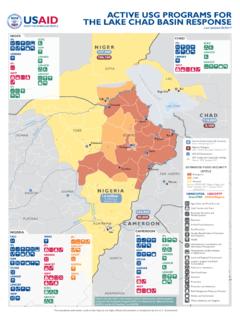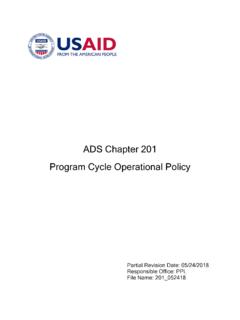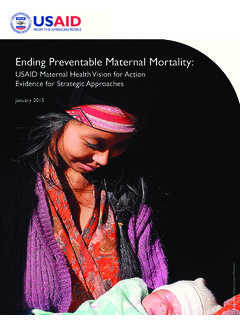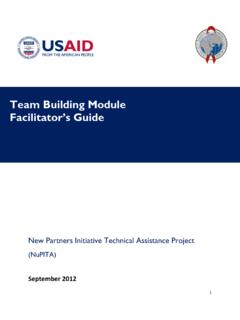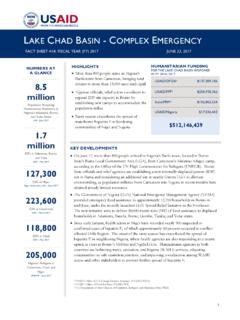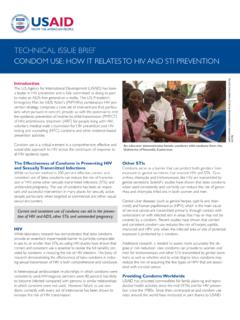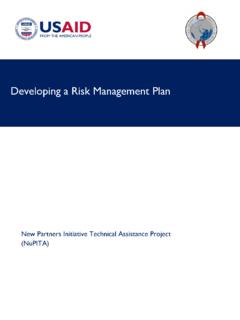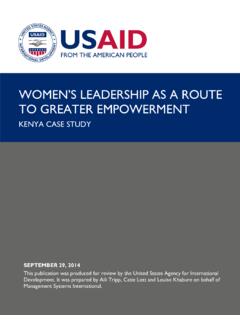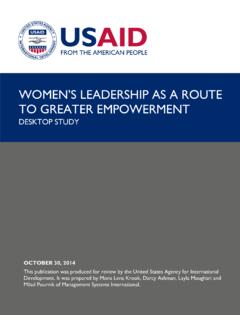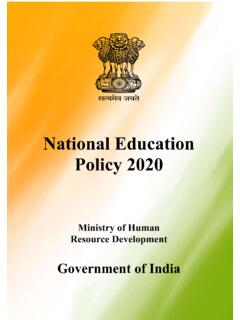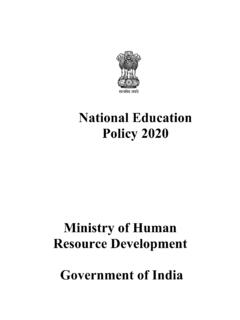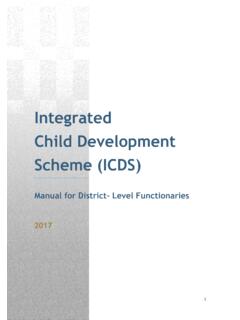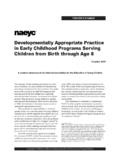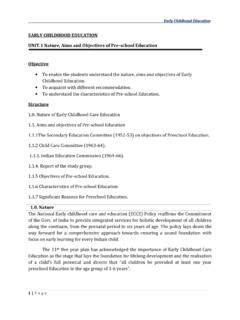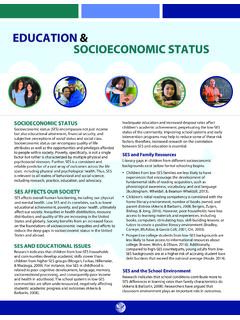Transcription of CHILD, EARLY, AND FORCED MARRIAGE RESOURCE GUIDE
1 CHILD, early , AND FORCED MARRIAGE RESOURCE GUIDESEPTEMBER 2015 This publication was produced for the united states agency for international development, usaid Contract number aid-oaa-i-14-00050/aid-oaa-To-14-00036. it was prepared by Banyan global and the international Center for research on Women (iCrW), under the authorship of alison M. glinski, Magnolia sexton, and lis Meyers through the advancing the agenda of gender Equality (adVanTagE) by:banyan Global1120 20th street nW, suite 950 Washington, dC 20036 Phone: +1 202-684-9367 Fax: +1 202-697-5020 Disclaimer: The authors views expressed in this publication do not necessarily reflect those of the united states agency for international development or the united states Credits: david snyder/iCrWproject Description: The Child, early , and FORCED MARRIAGE RESOURCE GUIDE task order under the adVanTagE idiQ is a strategy to implement the plan and vision outlined in the united states strategy to Prevent and respond to gender-Based Violence globally and usaid s Ending Child MARRIAGE & Meeting the needs of unmarried Children.
2 Under this task order, The Child, early , and FORCED MARRIAGE RESOURCE GUIDE was designed and developed to assist usaid staff to effectively integrate state-of-the art approaches to child, early and FORCED MARRIAGE prevention and response into their activities. This effort documented how the global health, gBV, youth, education , economic growth and workforce development, agriculture and food security, and legal reform sectors approach child MARRIAGE , including entry points, approaches, interventions and monitoring and evaluation, and provides concrete recommendations on how to improve these approaches in the Citation: glinski, allison M., Magnolia sexton, and lis Meyers. 2015. Washington, dC: The Child, early , and FORCED MARRIAGE RESOURCE GUIDE Task order, Banyan copies of The Child, early , and FORCED MARRIAGE RESOURCE GUIDE at : aid-oaa-i-14-00050/aid-oaa-To-14-00036 CHILD, early , AND FORCED MARRIAGE RESOURCE GUIDESEPTEMBER 2015 USAID CHILD, early , AND FORCED MARRIAGE RESOURCE GUIDE iACKNOWLEDGMENTSThe development of the Child, early , and FORCED MARRIAGE RESOURCE GUIDE was made possible through the generosity of the United States Agency for International Development (USAID).
3 It was prepared through the Advancing the Agenda of Gender Equality (ADVANTAGE) IDIQ, the Child, early , and FORCED MARRIAGE (CEFM) RESOURCE GUIDE Task Order. The Child, early , and FORCED MARRIAGE (CEFM) RESOURCE GUIDE Task Order is implemented by Banyan Global in collaboration with the International Center for Research on Women (ICRW). The authors of the RESOURCE GUIDE are Allison M. Glinski, Magnolia Sexton, and Lis authors thank Senior Gender Advisor, Dr. Felicia R. Wilson Young, from USAID s Office of Gender Equality and Women s Empowerment who provided leadership and technical guidance during all stages of the RESOURCE GUIDE s development. The authors are also grateful to USAID staff Vikki Stein, Susan A. Markham, Dr. Nancy Martin, and Mehlika Hoodbhoy for their valuable technical guidance and leadership. The authors thank the following individuals who participated in the Technical Advisory Group to develop this RESOURCE GUIDE contributing valuable guidance and feedback throughout the process: Allison Salyer (USAID) , Anita Raj, Annabel Erulkar, Chandra-Mouli Venkatraman, Ellen Travers, Gina Duclayan, Gwyn Hainsworth, Katharina Anton-Erxleben (USAID), Kiki van Kessel, Margaret Greene, Nancy Taggart, Sarah Hendriks, Shegufta Sikder (USAID), Stephanie Psaki, Sylvia Cabus (USAID), Wade Channell (USAID), and Wendy authors also benefitted enormously from interviews with additional USAID staff.
4 Erin Wroblewski, Habiba Akter, Jennifer Erie, Kakali Banik, Kristin Ray, Louise Fahnbulleh, Mahmuda Rahman Khan, Manju Tuladhar, Marc Bonnefant, Matthew Emry, Michal Avni, Monica Bautista, Rachel Marcus, Rebecca Goldman, Regina Jun, Sabita Shrestha, Siena Fleishcer, Tamara Shaya, Tegan Hare, Tej Gurung, and, Warkaye at Banyan Global Meaghan Smith, Janice Stallard, and Sara Cochran; Banyan Global interns Natasha Bashir Din, Andrew Walker, Leslie Giamo, and Julia Uriarte; and staff at ICRW Ann Warner, Suzanne Petroni, Lyric Thompson, Iba Reller, and Jennifer Parsons contributed time and effort in the development of the RESOURCE GUIDE . Special thanks to Cutting Edge Design for the graphic design and to our editors Zach Everson and Sara Rennekamp. USAID CHILD, early , AND FORCED MARRIAGE RESOURCE GUIDE iiCONTENTSGLOSSARY ..ivACRONYMS AND ABBREVIATIONS.
5 ViiTOP 12 WAYS TO USE THE CHILD, early AND FORCED MARRIAGE (CEFM) RESOURCE GUIDE ..xPART 1 Why Develop a RESOURCE GUIDE on CEFM? ..1 Understanding Child, early , and FORCED MARRIAGE ..4 PART 2 Multi-sectoral Approaches to Addressing CEFM ..14 Promising Interventions to End Child MARRIAGE and Serve Married Children ..14 Working Across Key Sectors and Incorporating CEFM Prevention and Response throughout USAID s Program Considerations for Gender Analysis ..21 Incorporating CEFM Prevention and Response across Key USAID Sectors and Strategies ..26 GBV ..27 Youth ..33 Global Health ..39 education ..46 Economic Growth and Workforce Development ..52 Agriculture and Food , Human Rights, and Governance ..65 Crisis and Conflict ..72 Multi-sectoral Programming ..79 Guidance on Working with Key Stakeholders ..81 Girls Who Are at Risk of CEFM or Who Are Already Married.
6 82 Boys (Including Boys at Risk of early MARRIAGE or Already Married) ..84 Male Family Members, Particularly Fathers and Brothers ..84 Parents and Guardians ..85In-laws and Other Key Gatekeepers ..86 Teachers and School Administrators ..86 Community, Traditional, and Religious Leaders ..87 Members of the Law Enforcement and Judicial Community ..87 Civil Society and the Media ..87 Women Leaders and Women s Organizations ..88 USAID CHILD, early , AND FORCED MARRIAGE RESOURCE GUIDE iiiLawmakers and Parliamentarians ..88 Governments ..89 Program Considerations for Regional Variations and Key Country Profiles ..90 South AsiaBangladesh ..91 India ..93 Nepal ..94 East and Southern AfricaEthiopia ..96 Tanzania ..98 West and Central AfricaBurkina Faso ..100 Latin America and the CaribbeanGuatemala ..102 PART 3 CEFM MONITORING AND EVALUATION (M&E) INDICATORS.
7 104 PART 4 KEY RESOURCES Seminal CEFM Resources ..122 Other Important Resources ..125 Table of Key Toolkits ..130 MEDIA KIT Key Messages on Child, early , and FORCED MARRIAGE ..139 Talking Points on CEFM and the GUIDE ..140 Social Media Kit for the CEFM GUIDE ..142 How Does Child, early , and FORCED MARRIAGE Impact Your Work Infographic ..144 REFERENCES ..146 FIGURES Figure 1: Global Prevalence of Child MARRIAGE ..4 Figure 2: Child MARRIAGE Prevalence (before 18 and 15) in Countries with the Highest National Rates ..6 Figure 3: Regional Variation in Prevalence of Girls 20 24 Married by Age Figure 4: Number of Girls Aged 20 24 Married by Age 18, in Millions ..8 Figure 5: Strategies to End Child MARRIAGE ..15 Figure 6: Integrating CEFM across Key USAID Sectors and Strategies ..16 Figure 7: USAID Program Cycle ..18 Figure 8: Stakeholders of CEFM: An Ecological Model.
8 81 Figure 9: Girls Pathways to Empowerment ..82 USAID CHILD, early , AND FORCED MARRIAGE RESOURCE GUIDE ivGLOSSARYB ehavior-change communication (BCC): Context-appropriate messaging strategies to promote healthy behaviors created by working with individuals, communities, and registration: An official record of a child s birth that provides state recognition of a child s existence and establishes his or her identity, nationality, kinship, and age. Birth registration is key for one s legal protection and access to essential services, including health, education , and legal spacing: The practice of timing the period between births, with the objective of achieving an optimal interval between price: The practice wherein a groom s family provides assets (such as property or money) to the bride s family as part of the MARRIAGE agents: People who facilitate the development, application, and advocacy for new or early MARRIAGE : A formal or informal union where one or both parties are under the age of labor: Work that is hazardous to a child's health, education , or physical or mental development and deprives children of their childhood , their potential and their education .
9 Instructional methods and programs aimed at connecting what is being taught in schools to the local communities, including local institutions, history, literature, cultural heritage, and natural environments. It is motivated by the belief that all communities have unique assets and resources that can be utilized to enhance learning cash transfers (CCTs): Programs aimed at reducing poverty or changing behaviors by distributing funds or resources directly to individuals or families who meet specified obligations. Conditions for child, early , and FORCED MARRIAGE -related CCTs might include ensuring girls attend school or educational workshops, or delaying MARRIAGE until a specified age. By ensuring that recipients meet certain requirements to qualify for the cash transfers, these programs incentivize behavior change and promote social responsibility while increasing violence: Experience of violence in the past 12 : The practice wherein a bride s family provides assets (such as property or money) to the groom s family as part of the MARRIAGE genital mutilation/cutting (FGM/C): All procedures involving partial or total removal of the female external genitalia or other injury to female genital organs for non-medical Fragile states: According to the Organisation for Economic Co-operation and Development, a fragile state has a weak capacity to carry out basic governance functions, and it lacks the ability to develop mutually constructive relations with society.
10 Fragile regions or states are more vulnerable to internal or external shocks, such as economic crises or natural disasters. More resilient states exhibit the capacity and legitimacy for governing a population and its territory. They can manage and adapt to changing social needs and expectations, shifts in elite and other political agreements, and growing institutional complexity. Fragility and resilience should be seen as shifting points along a USAID CHILD, early , AND FORCED MARRIAGE RESOURCE GUIDE vForced MARRIAGE : MARRIAGE at any age that occurs without the free and full consent of one or both spouses. It includes child and early MARRIAGE , as people under 18 are not able to give full : The social, cultural, behavioral and psychological traits and roles associated with males and females within specific social contexts. Gender analysis: A tool for examining the differences between the roles that women and men play in programs, institutions, systems, communities and societies; the different levels of power they hold; their differing needs, constraints, and opportunities; and the impact of these differences on their lives.
